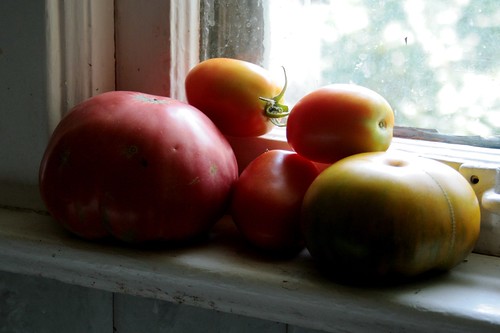
It's mid-July and some of my favorite crops, basil and tomatoes, are entering their peak periods. It's no wonder that the two are often served together, particularly in Caprese salad or atop bruschetta. Both have been staples in my garden over the past 3 years. A total no-brainer.
Like many herbs, basil is easy to grow, preferring a sunny spot and well-drained soil. Most books and seed packets recommend pinching leaves off the tops of seedlings to encourage sturdy, bushy growth. I would amend this, however, by suggesting you hold off pinching leaves once the plant is mature. Allow a week or two to pass between mature trimmings, so the plant can recoup and produce larger leaves in abundance. Most sources also suggest not allowing the plant to flower, since this will induce woody growth along the stem and stave off leaf production. Just pinch off the flowers as they come. You can get several harvest from a well-managed basil plant until the frost hits.
Though I like basil added to tomato dishes and otherwise, I like it best as a base for pesto. Since I starting shopping the farmers market and keeping a garden in my backyard, the production of copious amounts of pesto has become something of a summer ritual. Because our CSA has offered plenty of basil in addition to the 12 or so plants growing at home, I've already made and frozen a couple of batches. Of course, I love pesto so much that it doesn't last very long in the freezer.
My first pesto recipe came from the Betty Crocker Cookbook, which also offered a winter variation with spinach that was surprisingly tasty (though just not as good as the classic basil variety). Because I didn't yet have a food processor, I would make it in the blender. It was an arduous task, and if you're as serious about pesto as I am, I would highly recommend just shelling out $100 for a good quality food processor. In 2005, Everyday Food published a Basil Pesto recipe specifically designed for freezing, which omitted the cheese and ingeniously instructed one to quickly blanch and shock the basil to retain color. More recently, I've been using the recipe in Andrea Chesman's Serving Up the Harvest, which includes the cheese, and have not discovered any issues with its inclusion. On Sunday, Emily from Everything Begins With an E posted her own recipe using a local cheese.
With the right equipment, pesto is very easy to make. It really shines with high quality fresh ingredients (local if you can) and is a great addition to pasta, minestrone, or toast. I've even thrown it in omelets with good results. Plus you can freeze it for those long winter months, when basil is less abundant.
Another simple summer dish I love, and am gearing up to make this weekend, is salsa. Jalapenos are popping up on the bushes, and this week I've harvested a few of 'Enchantment' hydrid saladette tomatoes. In addition to the sweet onions and heirloom tomatoes I received yesterday from the CSA, I have the makings of quality salsa. Usually, I make the cooked down sauce variety you get in jars or at restaurants. This is the base recipe I use:
1 gallon quartered tomatoes
2 cups jalapeno peppers, chopped
1 cup onions, chopped
2 cups white or cider vinegar
1 cup sugar
1/4 cup pickling or kosher salt
Cook over low heat until thickened.
This recipe was given to me by my boyfriend's father a couple of years ago. Cook time depends on your preferred consistency. If you like really thick salsa, you might need to leave it on the stove up to 5 hours or whip out the crockpot. And don't take the recipe as biblical truth. I usually add a few cloves of garlic and cut the sugar by at least half, since I find the original recipe too candylike, covering the already sweet flavor of the tomatoes. I also like to cut the vinegar with lime juice, throw in cilantro at the end, or switch up the tomato and pepper varieties, depending on what I have onhand. If you want to can it, ladle into hot jars, seal, and process at 220F for about 10 minutes. It will also keep in your fridge, unprocessed, up to a month (possibly more, because of the vinegar) and can be frozen for future use.
In addition to the traditional sauce variety, you might like to try some fresh salsa, which is more like pico de gallo. Alex at Unaccustomed Earth posted a recipe for this dish on Tuesday. I made something it yesterday as a topping for nachos. My version used 2 saladette tomatoes, a jalapeno, juice from half of a lime, and some baby shallots quickly dug from the garden and washed. It's a great addition to most Mexican dishes and a good way to get rid of excess tomatoes fast. Just don't leave it in the fridge any longer than a couple of days.
As the height of the season continues, I'll no doubt be spending more time in the kitchen, whipping up more batches of pesto and salsa. What dishes do you make to take advantage of the season?